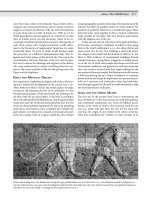Encyclopedia of society and culture in the ancient world ( PDFDrive ) 1243
Bạn đang xem bản rút gọn của tài liệu. Xem và tải ngay bản đầy đủ của tài liệu tại đây (46.6 KB, 1 trang )
1148
war and conquest: Greece
In Boeotia and a few other areas where federalism had
emerged, there were federal armies with member states contributing troops according to population, and command was
held by federally elected officers. Elite units are mentioned at
Thebes in Boeotia and at Argos in the fift h and fourth centuries b.c.e., but we know almost nothing of their organization.
Given that most Greek armies were militias, it is probable
that they were commanded by each city’s magistrates.
The Peloponnesian War (431–404 b.c.e.) between Athens
and Sparta and its allies precipitated a number of changes.
For the first time mercenary troops from the poorer regions
of Greece were employed on a large scale as well as specialist troops drawn from non-Greek sources. The dominance of
the hoplite outside of decisive battles was reduced. Combined
forces of light-armed troops, cavalry, and hoplites were shown
to be effective in small-scale actions. The length of the war and
the employment of mercenaries led to a growing professionalism, visible both at the level of the individual soldier and in
positions of command. The greater professionalism and frequent warfare in the fourth century b.c.e. led to the development of new tactics and changes in hoplite equipment.
In these years Greek politics had essentially become bipolar, with most Greek states aligned with either Sparta or
Athens. In addition to the war’s effect on the nature of warfare, this conflict also had profound political consequences. It
destabilized a number of states, leading to internal factional
fighting, which was often bloody. A number of cities were destroyed and the population enslaved. It led to the Spartans’
realization that the older strategy of laying waste to an opponent’s agricultural land as the key to victory no longer held
in Athens’s case, since as long as Athens dominated the sea,
it could supply itself from overseas. This realization led the
Spartans to solicit Persian money to subsidize their navy and
so involved them in the affairs of the Greeks of Asia Minor.
By the end of the war Sparta stood supreme. Athens was
subordinated but not destroyed so that it could serve as a counterweight to the ambitions of Thebes. However, Spartan blunders created a number of coalitions of major Greek states to
oppose Sparta. Sparta’s supremacy lasted until 371 b.c.e. and
Sparta’s defeat in battle by Thebes, which now assumed Sparta’s
role. By 362 b.c.e. Sparta’s ascendancy had ended, and no state
emerged as dominant; rather, there was a series of combinations in an attempt to limit the power of any one state.
THE FOURTH CENTURY B.C.E.
The rise of Macedonia radically changed the situation. The
most crucial development of the fourth century b.c.e. was the
rise of a powerful and expansive monarchy in Macedonia. Its
creation was the work of Philip II (r. 359–336 b.c.e.). Philip
consolidated a weak state rent by faction and in the process
created an army superior to any the Greek world had yet
seen. Macedonia had always had effective cavalry, but it was
Philip’s achievement to develop a superb infantry. Its organization must be inferred from Alexander’s army, whose structure is far better known. The cavalry was organized into eight
units, one being the royal cavalry of 300, which also served
as a bodyguard. The other seven units were each 200 to 300
men strong. The infantry phalanx was levied by geographical
areas and by the end of Philip’s reign was 24,000 strong and
divided into sections of 1,500. Two other infantry units are
known, one of 250 and one of 16. There were also substantial numbers of light-armed troops of all types drawn from
Macedonian and subject populations, who also provided specialized units. The king was normally in command and had a
number of senior commanders drawn from the Macedonian
nobility, who commanded units on the battlefield and in independent expeditions. The Macedonian army represented
a departure from traditional Greek forces. For the first time
a force was created that effectively used different modes of
fighting in combination in large-scale battle.
The army that Philip’s son, Alexander the Great (r.
336–323 b.c.e.), led against Persia in the spring of 334 b.c.e.
was essentially the force his father had created except for a
substantial presence of allied Greek contingents. It probably
differed only in having a higher proportion of cavalry, since
the main Persian strength was concentrated in that arm. One
innovation Alexander may have made was the creation of an
elite infantry guard, the hypaspists of 3,000 men who were
armed in the same manner as other heavy infantry and under the direct command of the king. Attrition, distance, and
Alexander’s own vision led to an attempt to incorporate Oriental troops into his army. Oriental cavalry were added to the
army as Alexander advanced eastward, but they were kept
separate from Macedonian troops. Orientals were denied positions of command except in special circumstances.
Alexander’s conquests of the Persian Empire and northwestern India created the initial conditions for a massive movement of population from Greece and Macedonia to the Near
East. This movement, over by about 250 b.c.e., led to the spread
of Greek culture and the extensive urbanization in the Near
East. The kingdoms of Alexander’s successors were controlled
by Greeks and adopted Greek political practices. The military
forces continued and completed a military revolution. The use
of professional soldiers culminated in the professional standing armies of the Ptolemies and the Seleucids. Militia-based
armies continued to exist on mainland Greece and in Macedonia, but even there professional soldiers were employed on a
substantial scale. These were much more heterogeneous armies
than those of the Classical Period (480–323 b.c.e.), consisting
of Greeks, Macedonians, and mercenaries drawn from all over
the Mediterranean as well as levies of subject peoples. War and
conquest had created Greek states on a far vaster scale than
earlier. Despite these advantages, none of the monarchies created in the wake of Alexander’s death was capable of resisting
the advance of a Roman army based on the militia system.
Alexander’s death in 323 b.c.e. led to a half century of
struggle, which ended in the establishment of three large
successor kingdoms: the Ptolemaic based in Egypt, the Seleucid, whose territory stretched from the seacoast of Asia
Minor to northwestern India at its greatest extent, and the









